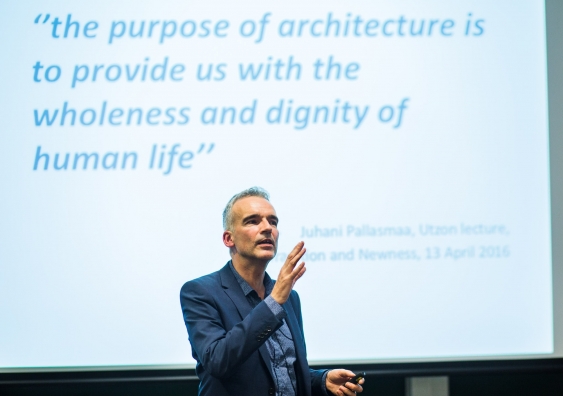In the face of unprecedented urban migration we need our cities to be more resilient, and architects have a critical role to play, says international disaster risk-reduction expert David Sanderson.
“With over half the world’s population now living in urban areas, we need to build resilient cities to manage the potential over-crowding, poverty and natural disasters that will result from climate change,” Professor Sanderson, UNSW’s inaugural Judith Neilson Chair in Architecture, has told an audience at the UNSW Built Environment Utzon lecture.
“Cities are growing by one million people per week and 30% of poorer countries’ populations are living in slums,” he told the audience. “By 2050 that could reach 60%. This situation is only going to get worse and aid agencies are currently woefully unequipped to deal with it.”
Increasing post-disaster community resilience through the provision of good housing is critical and built environment professionals and architects should be trained to help, Sanderson said. “Architects need to move beyond their traditional role of designing buildings in places of relative certainty, to becoming facilitators of building processes that involve people in places of uncertainty and rapid change."
He said aid organisations tend to rely on the provision of temporary shelters that are often slow to arrive, expensive and inappropriate to local needs. An example was the communities still living in tents and other temporary shelters years after Typhoon Haiyan struck the Philippines in 2013, the Haiti earthquake in 2010 and last year’s earthquakes in Nepal were prime examples.
“Architects need to move beyond their traditional role of designing buildings in places of relative certainty, to becoming facilitators of building processes that involve people in places of uncertainty and rapid change”
The long-term solution lies in mobilising communities to rebuild their own homes.
“Effective post-disaster shelter needs to have the long-term in mind, as well as meeting immediate need. It should be low cost, allowing more shelter to reach more people and involve local builders and materials which then boosts the economy. Above all, effective shelter projects should put those affected in the centre of the process – people themselves should have the option to decide what they want and how they will use it.
“It may sound counter-intuitive but relief can be the enemy of recovery, because it promotes a ‘saviour mentality’ in those who come to help – aid is always needed but the challenge comes when too much aid is given for too long and people lose the ability to recover on their own merits,” Sanderson said.

Cities are growing by one million people per week and 30% of poorer countries’ populations are living in slums. Photo:Shutterstock
Sanderson is the inaugural Judith Neilson Chair in Architecture at UNSW. The first of its kind in Australia, the Chair was established in 2015 with a $10 million endowment from philanthropist and White Rabbit Gallery founder Judith Neilson.
In a message read by UNSW Built Environment Dean Professor Helen Lochhead, Neilson congratulated Sanderson on his inaugural lecture and explained the background to her endowment.
“I’ve always felt that after food, having a secure place to live is the next most important element in anyone’s life and vital to a sense of self-worth. I’ve watched with increasing apprehension the dramatic rise in the number of people and communities who suffer serious hardship, often losing everything, including their homes, through the impacts of climate change and the devastation that follows geo-political conflict.
“I thought that for Australia to develop ways to better support communities experiencing serious disadvantage, both here and around the world, it needs first and foremost intellectual leadership. And that we also needed more young people graduating from universities with a profound exposure to the issues of disadvantage to increase awareness and perhaps attract more bright minds to careers committed to the betterment of others less fortunate.”
Sanderson is currently leading UNSW Built Environment’s Master of Architecture (Social Agency) program, which involves 18 students working on-site at St Canices Church in Kings Cross to design a redevelopment of the church in consultation with the parish community.



